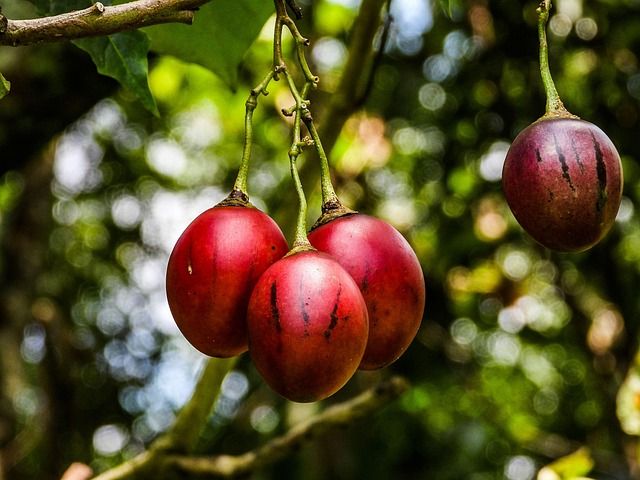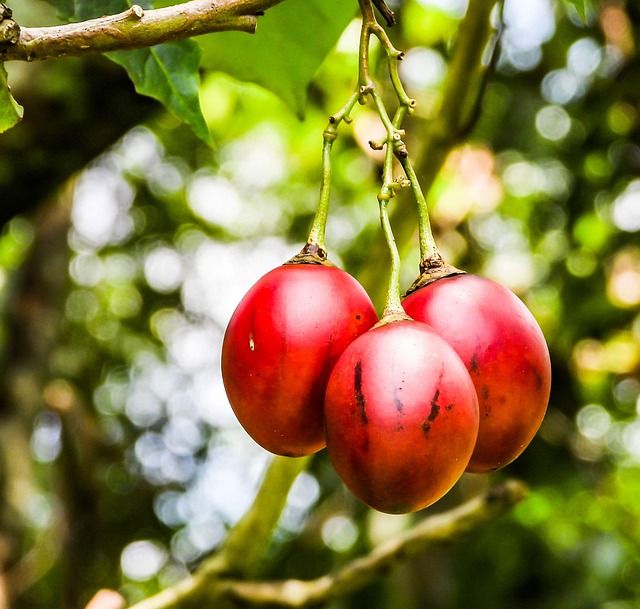
VERSIÓN ESPAÑOL:
¿Cómo va la gente de Blurt?
Les aúllo el chisme por el que seguro vienen a leer a mi cueva de meditación:
El tomate de árbol, conocido científicamente como Solanum betaceum, es una fruta originaria de los Andes, cultivada en diversas regiones de Sudamérica. Su forma es ovalada y su piel puede variar entre tonos rojos, naranjas y amarillos, dependiendo de la variedad. La pulpa es jugosa, de color anaranjado intenso, con pequeñas semillas comestibles. Su sabor es una combinación entre lo ácido y lo dulce, con un ligero toque cítrico.
Este fruto es apreciado tanto por su valor nutricional como por su versatilidad en la cocina. Es rico en vitaminas A, C y antioxidantes, además de contener minerales como potasio y magnesio. Se consume en jugos, salsas, postres y ensaladas, e incluso puede cocinarse para preparar mermeladas y salsas agridulces.
Su cultivo requiere climas templados y altitudes moderadas, con temperaturas que no sean extremas. Se desarrolla mejor en suelos bien drenados y con buen contenido de materia orgánica. Es una planta de rápido crecimiento que puede alcanzar varios metros de altura y empieza a dar frutos aproximadamente entre los 12 y 18 meses después de la siembra.

Además de su uso en la gastronomía, se le atribuyen propiedades medicinales, como el fortalecimiento del sistema inmunológico y la regulación de la presión arterial. Su alto contenido de fibra también favorece la digestión. Debido a su creciente demanda, su producción y exportación han aumentado en diferentes países, convirtiéndolo en un fruto cada vez más reconocido en mercados internacionales.
El consumo de tomate de árbol aporta múltiples beneficios para la salud debido a su riqueza en vitaminas, minerales y antioxidantes. Su alto contenido de vitamina C fortalece el sistema inmunológico, ayudando a prevenir resfriados y otras enfermedades. Además, esta vitamina favorece la producción de colágeno, contribuyendo a la salud de la piel y los tejidos.
Gracias a su concentración de antioxidantes, como los flavonoides y carotenoides, el tomate de árbol ayuda a combatir el daño celular causado por los radicales libres, lo que puede reducir el riesgo de enfermedades crónicas. Su contenido de fibra favorece la digestión y mejora el tránsito intestinal, previniendo el estreñimiento y promoviendo la salud del sistema digestivo.
El potasio presente en esta fruta es esencial para la función cardiovascular, ya que contribuye a la regulación de la presión arterial y ayuda a mantener el equilibrio de líquidos en el organismo. Su bajo contenido en calorías y grasas lo convierte en un alimento ideal para quienes buscan mantener un peso saludable sin renunciar a una alimentación nutritiva.

También se ha señalado que el tomate de árbol puede tener efectos positivos en la reducción del colesterol y la glucosa en sangre, lo que lo convierte en una opción favorable para personas con riesgo de enfermedades metabólicas. Su capacidad para mejorar la circulación sanguínea y su acción antiinflamatoria lo hacen beneficioso para el bienestar general.
Además de sus propiedades nutricionales, su versatilidad en la cocina permite incluirlo en una gran variedad de preparaciones, lo que facilita su incorporación en una dieta equilibrada. Su combinación de sabor y beneficios lo convierte en un alimento valioso tanto para el consumo diario como para la gastronomía en distintas culturas.
Aunque el tomate de árbol es una fruta altamente nutritiva, su consumo excesivo puede generar algunos efectos secundarios en ciertas personas. Debido a su acidez, ingerir grandes cantidades puede provocar irritación en el estómago, especialmente en quienes padecen gastritis o reflujo gastroesofágico. Su contenido ácido puede aumentar la producción de jugos gástricos, lo que podría causar molestias como ardor estomacal o sensación de acidez.
El alto contenido de fibra, si bien es beneficioso para la digestión, en exceso puede generar efectos adversos como diarrea, hinchazón o malestar abdominal, especialmente en personas con un sistema digestivo sensible. Además, su consumo desmedido podría interferir con la absorción de ciertos nutrientes, afectando el equilibrio intestinal.

Otro aspecto a considerar es su contenido en potasio. Aunque este mineral es esencial para la función cardiovascular, un exceso en la ingesta podría ser perjudicial para personas con enfermedades renales, ya que los riñones pueden tener dificultades para eliminar el exceso de potasio del organismo, lo que puede afectar el ritmo cardíaco.
En algunos casos, el tomate de árbol puede generar reacciones alérgicas en individuos sensibles a los frutos de la familia Solanaceae, a la que también pertenecen el tomate común, la papa y la berenjena. Los síntomas pueden incluir picazón, hinchazón o molestias digestivas leves.
Además, debido a su efecto sobre los niveles de azúcar en sangre, las personas con diabetes deben consumirlo con moderación, ya que aunque tiene un índice glucémico bajo, en grandes cantidades podría influir en la regulación de la glucosa.
Ya los leo más tarde.
Chau.
ENGLISH VERSION:
How's it going, Blurt folks?
I am telling you the gossip that you are surely coming to read in my meditation cave:
The tree tomato, scientifically known as Solanum betaceum, is a fruit native to the Andes, cultivated in various regions of South America. Its shape is oval and its skin can vary between red, orange and yellow tones, depending on the variety. The pulp is juicy, deep orange in color, with small edible seeds. Its flavor is a combination of acid and sweet, with a slight citrus touch.
This fruit is appreciated both for its nutritional value and for its versatility in the kitchen. It is rich in vitamins A, C and antioxidants, as well as containing minerals such as potassium and magnesium. It is consumed in juices, sauces, desserts and salads, and can even be cooked to prepare jams and sweet and sour sauces.
Its cultivation requires temperate climates and moderate altitudes, with temperatures that are not extreme. It grows best in well-drained soils with a good organic matter content. It is a fast-growing plant that can reach several meters in height and begins to bear fruit approximately 12 to 18 months after planting.

In addition to its use in gastronomy, it is credited with medicinal properties, such as strengthening the immune system and regulating blood pressure. Its high fiber content also favors digestion. Due to its growing demand, its production and export have increased in different countries, making it an increasingly recognized fruit in international markets.
The consumption of tree tomato provides multiple health benefits due to its richness in vitamins, minerals and antioxidants. Its high vitamin C content strengthens the immune system, helping to prevent colds and other diseases. In addition, this vitamin favors the production of collagen, contributing to the health of the skin and tissues.
Thanks to its concentration of antioxidants, such as flavonoids and carotenoids, tree tomato helps fight cell damage caused by free radicals, which can reduce the risk of chronic diseases. Its fiber content favors digestion and improves intestinal transit, preventing constipation and promoting the health of the digestive system.
The potassium present in this fruit is essential for cardiovascular function, as it contributes to the regulation of blood pressure and helps maintain fluid balance in the body. Its low calorie and fat content makes it an ideal food for those seeking to maintain a healthy weight without giving up a nutritious diet.

It has also been noted that the tree tomato can have positive effects on lowering cholesterol and blood glucose, making it a favorable option for people at risk of metabolic diseases. Its ability to improve blood circulation and its anti-inflammatory action make it beneficial for general well-being.
In addition to its nutritional properties, its versatility in the kitchen allows it to be included in a wide variety of preparations, which facilitates its incorporation into a balanced diet. Its combination of flavor and benefits makes it a valuable food both for daily consumption and for gastronomy in different cultures.
Although the tree tomato is a highly nutritious fruit, excessive consumption can cause some side effects in certain people. Due to its acidity, ingesting large quantities can cause irritation in the stomach, especially in those who suffer from gastritis or gastroesophageal reflux. Its acidic content can increase the production of gastric juices, which could cause discomfort such as heartburn or a feeling of acidity.
Although high fiber content is beneficial for digestion, excessive amounts can cause adverse effects such as diarrhea, bloating or abdominal discomfort, especially in people with a sensitive digestive system. In addition, excessive consumption could interfere with the absorption of certain nutrients, affecting intestinal balance.

Another aspect to consider is its potassium content. Although this mineral is essential for cardiovascular function, excessive intake could be harmful to people with kidney disease, as the kidneys may have difficulty removing excess potassium from the body, which can affect heart rate.
In some cases, tree tomato can cause allergic reactions in individuals sensitive to fruits from the Solanaceae family, which also includes the common tomato, potato and eggplant. Symptoms may include itching, swelling or mild digestive discomfort.
In addition, due to its effect on blood sugar levels, people with diabetes should consume it in moderation, since although it has a low glycemic index, in large quantities it could influence glucose regulation.
